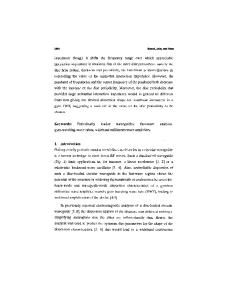Dispersion Characteristics of Dielectric Loaded Multiple V-Ridge Waveguide
- PDF / 630,502 Bytes
- 8 Pages / 439.37 x 666.142 pts Page_size
- 105 Downloads / 424 Views
Dispersion Characteristics of Dielectric Loaded Multiple V-Ridge Waveguide Guojian Li & Fuyong Xu & Aning Ma & Yinqin Cheng
Received: 26 April 2007 / Accepted: 5 June 2007 / Published online: 6 July 2007 # Springer Science + Business Media, LLC 2007
Abstract A new kind of V-ridge waveguide is presented in this paper. The transmission problem is solved by edge element for the first time. The field patterns of the waveguide with single, double and triple V-ridge for different values of dielectric constant have been presented. Variations of the cutoff wavelength, single-mode bandwidth with the ridge dimensions for different values of dielectric constant are investigated in detail. The results will be of practical significance in designing ridge waveguide components in microwave and millimeter wave engineering. Keywords Multiple V-ridge waveguide . Edge-based finite element method . Dispersion characteristics . Dielectric loaded waveguide
1 Introduction Ridge waveguide plays an essential role in microwave and millimeter component. A variety of ridge waveguide have been proposed and developed, because of their unique characteristics such as low cutoff frequency, wide bandwidth, and low impedance characteristics [1, 2]. Mai Lu and Mikael Persson studied trapezoidal-ridge waveguide by finite element method [3]. Ng and Chan studied dielectric-loaded ridge waveguide by mixed spectral-domain method [4]. Sun and Balianis studied quadruple-ridged square waveguides (QRSW) by MFIE [5]. Ridge waveguide partially filled with dielectric have an important feature, i.e., ridge waveguide can be miniaturized by loading dielectric in it, which is very useful in practical applications. Mai Lu studied dielectric loaded double trapezoidal-ridge waveguide by finite element method [6]. Helszajn systematically investigated the dielectric loaded square waveguide by numerical calculations [7]. G. Li (*) : F. Xu : A. Ma School of Information Science and Engineering, Lanzhou University, Lanzhou 730000, The People’s Republic of China e-mail: [email protected] Y. Cheng School of Computer Science and Information Engineering, Northwest University for Nationalities, Lanzhou 730000, The People’s Republic of China
726
Int J Infrared Milli Waves (2007) 28:725–732
c
r
ε0
b
c
εr
d
ε0
b
ε0
ε0
d
εr
ε0
a
a
b Double V-ridge
c
ε0
εr
d
a Single V-ridge
b
c
t
εr
d
ε0
a
d
c
εr
ε0
d
εr
ε0
c TripleV-ridge
Fig. 1 Dielectric loaded multiple V-ridge waveguide.
A number of different methods are available for solving waveguide problems. Finite element method offers the most powerful and efficient numerical solution to the various problems in electrical and electronic engineering, especially to waveguide problems [8]. By ensuring only tangential continuity of the field components across element boundary the edge-based FEM completely wipe out the spurious modes. However, the finite difference analysis has difficulty in dealing with geometrically irregular structures, it is difficult to analyze transmission characteristics accurately
Data Loading...










